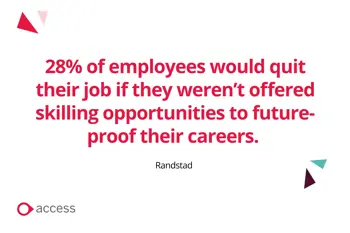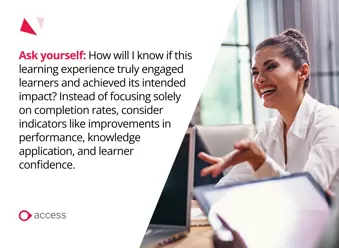Designing engaging learning experiences: 8 Expert Tips
Learning programmes that fail to engage results in learning that is forgettable. Creating engaging training content starts long before the first slide or video—it begins at the design stage, and it’s often the crucial difference between passive content and transformative learning.
In this article, we share eight expert tips for designing engaging learning experiences and discuss the importance of understanding the success criteria for your learning programmes.
The importance of engaging learning content
Learning in the workplace has never been more crucial. A recent report by Randstad found 28% of employees would quit their job if they weren’t offered skilling opportunities to future-proof their careers. But simply offering learning isn’t enough - how it’s delivered matters.
For learning experiences to be meaningful and drive results, they need to be designed with engagement in mind. When content fails to capture attention or feels disconnected from day-to-day work, learners quickly disengage—and the opportunity for growth and tangible results is lost.

Creating engaging training content: 4 important pre-design considerations
Before diving into the design process, it’s crucial to lay a strong foundation for your training content. Here are four important considerations to keep in mind prior to designing your content.
1. Understand your learners
Without a fundamental understanding of your learners, your content risks falling flat and failing to resonate. If you don’t know their prior knowledge, learning preferences, motivations, and potential barriers, you’re essentially designing in a vacuum.
2. Define clear learning objectives
Before you begin designing, ask yourself, "What do I want learners to achieve by the end of this course?" Setting clear, measurable learning objectives is crucial for guiding both the design and evaluation of your content, ensuring its overall success.
3. Consider the learning environment
The learning environment plays a significant role in shaping your content design. For example, traditional in-person training will require different design elements than one that is online, or a blended approach which involves both methods. Understanding how the learning will be delivered helps determine which tools and strategies will be most effective.
4. Think about how the content will be promoted
Creating great training content is only part of the equation; ensuring that learners engage with it is equally important. Think about how the content will be promoted and communicated to your audience, and more importantly, how it clearly answers the question every learner asks: “What’s in it for me?” A Learning Management System which draws on marketing principles with the option to create targeted learning campaigns will ensure learners are aware of the training and motivated to participate.

8 tips for creating engaging training content
We’ve covered why engaging learning content is key for employee and organisational success and what to think about before you begin, now let’s explore how to design engaging learning experiences.
Tip 1: Target your content
Learning isn’t one-size-fits all; learners have different levels of knowledge and understanding as well as the ways they prefer to learn. By providing a variation of content types and targeting your content to specific job roles and interests with the help of an LMS, you can ensure you are providing your employees meaningful and relevant content.
Tip 2: Incorporate interactive elements
Keep learners interested and involved with an eLearning library by incorporating activities like quizzes, polls, drag-and-drop exercises, and simulations within your learning design. This will help make complex topics easier to understand and remember.
Tip 3: Tell compelling stories
Stories can create emotional connections and help learners see the practical application of the information given to them. By incorporating storytelling elements into your design, you can develop engaging eLearning experiences that capture attention and truly resonate with your learners.
Tip 4: Use real world examples
Incorporating real-world examples into your eLearning content helps to bridge the gap between theory and practice. By using scenarios that learners can recognise from their own lives or professions, they are more likely to retain the information given to them and engage with the learning.
Tip 5: Keep it short
Adding unnecessary information and complex segues will instantly turn a learner off. Instead, respect learners' time and attention spans by breaking down complex topics into smaller, bitesize chunks. This type of content will be easy to digest and more memorable, resulting in better knowledge retention.
Tip 6: Offer gamified learning
Incorporating gamification into your training can dramatically boost motivation, especially for remote and hybrid workers who may miss out on in-person energy and camaraderie. A well-designed gamified learning activity hosted on a slick platform with elements such as points, badges and leaderboards encourages friendly competition between players and helps to make learning stick.
Tip 7: Provide social learning opportunities
When learners collaborate, share insights, or reflect together, they build knowledge through interaction. For those working remotely, these kinds of interactions are essential. Engaging learners in online learning environments means creating opportunities for meaningful social interaction. Build opportunities for collaboration among learners in your learning designs. You could link to discussion forums, provide easy share links to learning content or peer feedback opportunities through comments and ratings. Designing your learning content for easy adaption to live virtual classrooms can also be effective for creating real-time connections.
Tip 8: Utilise Subject Matter Experts (SME’s)
When planning and designing engaging eLearning courses, collaborating with Subject Matter Experts (SMEs) is key. Their expertise not only enhances the credibility of your content but also supports learners by providing depth and authenticity. When you involve SMEs at the design stage, they help to shape scenarios, review content and provide an authentic and
Understanding the success criteria for your eLearning engagement
Designing engaging learning experiences doesn’t end once the content is created—it continues through how you measure success and adapt over time. To ensure your efforts lead to meaningful, tangible outcomes, it’s essential to establish clear success criteria from the outset.
Ask yourself: how will I know if this learning experience truly engaged learners and achieved its intended impact? Instead of focusing solely on completion rates, consider more telling indicators such as improvements in performance, knowledge application, and learner confidence.
Feedback also plays a key role in sustaining engagement. When learners receive timely, constructive feedback, they gain clarity on their progress and feel more connected to the learning process. This sense of support and direction encourages continued participation and deeper learning.
A well-chosen LMS is a powerful tool in designing and sustaining engagement. It not only delivers the content but also tracks how learners interact with it—capturing key data on participation, assessment scores, time spent, and engagement with various elements. These insights allow you to continuously refine your eLearning content, ensuring it remains relevant, effective, and aligned with the needs of your learners.
Boost engagement with our learning solutions
Our suite of Digital Learning Solutions includes high quality, accredited eLearning courses designed to capture and maintain the attention of learners.

Speak to an expert
Chat with one of our learning experts and find out how Access Learning can be tailored to meet the needs of your business, regardless of size.

Build a high-performing workforce
Our AI-powered LMS keeps your people engaged with an intuitive user interface and innovative features to drive engagement.

View our eLearning library
Explore our extensive eLearning library, written by experts and designed to enhance the learning requirements of your organisation.

 AU & NZ
AU & NZ
 SG
SG
 MY
MY
 US
US
 IE
IE

